Employer Branding Campaigns: Examples and Templates
Employer branding is a relatively broad concept, which makes it tricky for you to take actionable steps to meaningfully improve your employer brand.
To solve this problem, we have identified a handful of employer brand campaign templates you can leverage to improve your employer brand today.
We’ve also provided several specific instances of outstanding employer branding to inspire your strategy.
What Is Employer Branding?
Employer branding is a company’s reputation as an employer among current employees and the general public.
It encompasses how a company treats its employees, career growth opportunities, employee perks, core values, and other factors contributing to the overall employee experience.
Companies with strong employer branding have a significant advantage in recruiting and retaining top talent. They also tend to have more engaged and productive workforces.
Examples of Employer Branding Campaigns
There are plenty of reputation management hacks you can leverage to improve the general public's perception of your company as an employer. However, it's often much more productive to focus on improving the internal company culture.
If employees love working with your brand, word will spread naturally, and you won't have to work as hard to improve the employer brand image.
Here are some examples of employer branding initiatives you can implement to improve the employee experience so that employees stay with your company longer, refer job opportunities to their friends, and spread positive brand awareness through word of mouth.
Host Company Events
When co-workers see each other in person and out of the context of work, they build more meaningful connections.
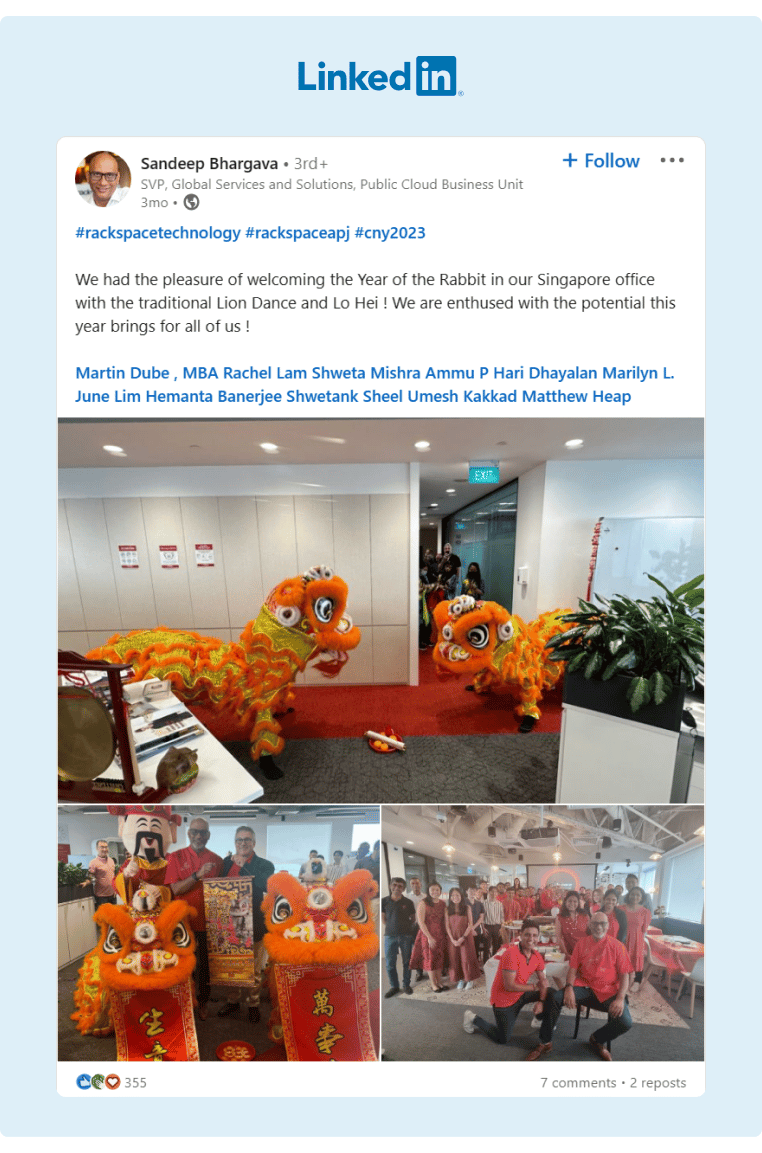 Source: Sandeep Bhargava
Source: Sandeep Bhargava
This can help improve productivity as they'll feel more comfortable discussing challenging situations and will work together more effectively to solve problems. In addition, employees that genuinely enjoy their co-workers will be more hesitant to leave the company.
Offer Wellness Perks
Wellness perks factor into 87% of employees' decisions when choosing an employer, and about 72% of companies implementing wellness perks see reduced healthcare costs.
Offer perks like gym membership subscriptions, mental health initiatives (meditation app subscriptions), and healthy eating initiatives (like subscriptions to SnackNation).
Provide Career Growth Opportunities
Offering tempting career growth opportunities will help you attract top talent that values continuous learning. As an added bonus, it will also help you create a growth mindset within your company and help you retain your best employees.
Some examples of career growth opportunities include speaking opportunities, paying for courses and workshops, and a budget for coaching.
Incorporate Employee Engagement Activities
Company events are a great way to help employees get to know each other on a deeper level, but you'll still need other daily engagement activities to build strong relationships among employees and keep the team aligned on the vision and mission.
One solution is to use an internal communication tool like GaggleAMP that makes it easy for remote and in-person teams to stay connected with their co-workers.
For example, inside our company Gaggle, we have a Community module where we can have internal discussions and share with one another. One of our most popular channels is our pets channel where employees can get to know each other more personally by sharing about their pets, many of which have made appearances on our Zoom calls.
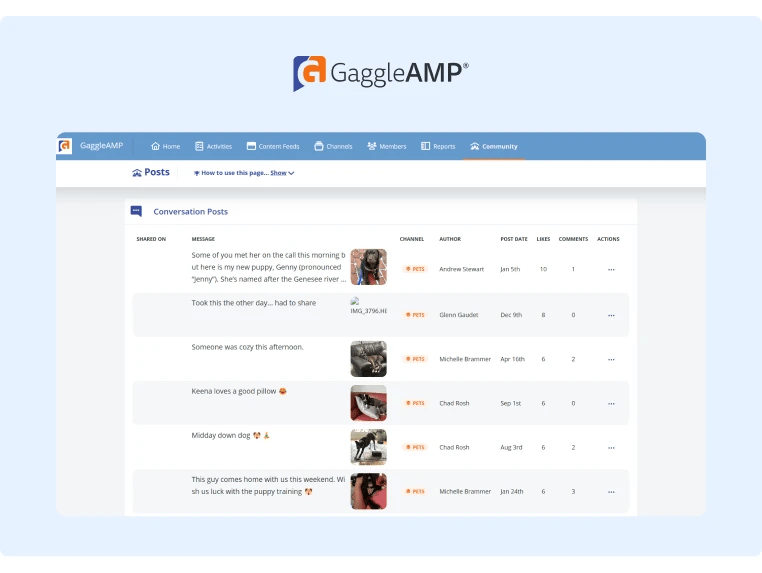
Another form of employee engagement is employee advocacy.
The idea behind employee advocacy is that employees act as brand ambassadors by engaging with the company’s social media content and promoting key brand initiatives on their personal social media profiles.
The LinkedIn post below is a great example of employee advocacy where one of Archer’s employees shared a significant milestone from their company with their social media followers.
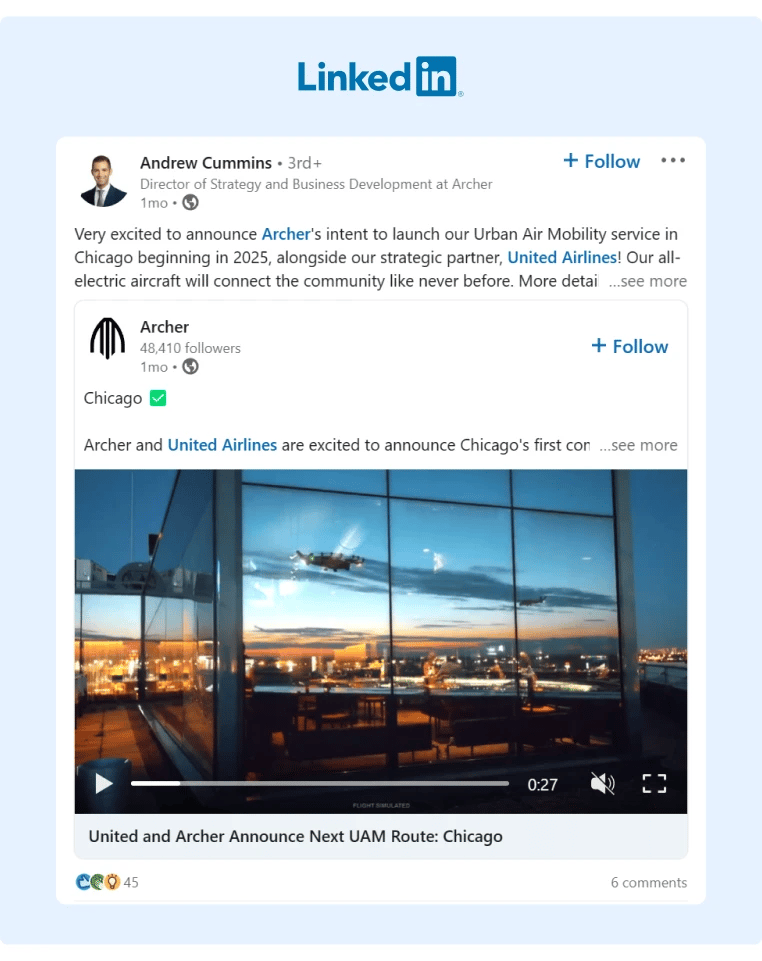
Source: Andrew Cummins
This keeps current employees up-to-date with major company achievements and helps team members stay aligned with the company’s vision.
As an added bonus, sharing impressive accomplishments also aids your employer branding strategy by attracting new talent, since everyone wants to join growing companies solving big problems.
The only drawback of employee advocacy is that it can be a challenge to coordinate employee engagement. Therefore, we built GaggleAMP to make it easy to create and assign employee engagement activities at scale and then track the results of your employee advocacy efforts.
Regularly Collect Employee Feedback
One of the best ways to keep existing employees happy is to listen to what they want and then implement the changes they request.
You can use a survey tool like SurveyMonkey or Typeform to run surveys and collect detailed feedback or implement a tool like Geekbot to collect automated daily employee feedback.
Another great employer brand strategy is to ask managers about cultural issues that arise in one-on-one meetings.
Provide Meaningful Employee Benefits
Offering great health insurance packages is the top benefit that job seekers consider when selecting a new employer.
Improving the company's basic health insurance offer is one of the best ways to significantly improve your employee value proposition (EVP) and win the best talent.
Other important benefits employees look for include paid holidays, paid vacation, paid sick days, and access to retirement savings plans.
Real Employer Branding Strategy Examples
Once you've dialed in your internal employer branding strategy, show off the best aspects of your brand on social media channels to attract potential candidates. Here are a few examples of companies that have done an excellent job of demonstrating their employer branding efforts.
6sense
6sense is a great example of a company with a strong employer brand that regularly encourages employees to share their career journey stories on social media.
Here's one example of a post created by an employee that the brand later shared on the company page. These employee testimonials tend to be most effective as people generally trust other people more than brands:
6sense also frequently promotes its self-care and work-life balance initiatives, which demonstrate that their company values employee well-being:
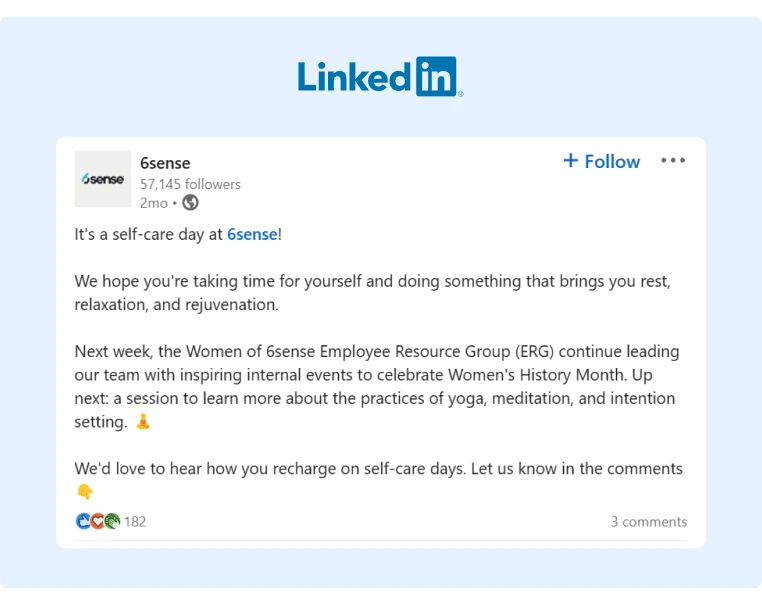 Source: 6Sense
Source: 6Sense
SmartBug Media
SmartBug Media is another great example of a brand that uses employee stories to show off its employer branding. This post, created by one of their marketing strategists, shows that the company values work-life balance:
SmartBug Media gets employees to consistently share content by assigning engagement activities in their employee advocacy efforts. Before using GaggleAMP, they tried manually encouraging employees to engage with company content, but employees often forgot or wouldn't know what brand initiatives to discuss.
These problems are solved by allowing SmartBug’s CEO to specify what content employees should create and how they should engage.
Chili Piper
Chili Piper is excellent at communicating its employer branding strategy through its employees.
Here's a great example where they allow an employee to publish a post directly on the company's LinkedIn page to share their growth opportunities at Chili Piper.
In this case, the employee shared that he stepped down from an SDR management position at another company to take a regular SDR job at Chili Piper. In his post, he discussed that all of his friends said it was a big mistake. This employee then continued to explain how taking the job at Chili Piper has accelerated his career and why he believes Chili Piper is an excellent employer.
This is a great example of how you can show off your company's career growth opportunities through employee stories.
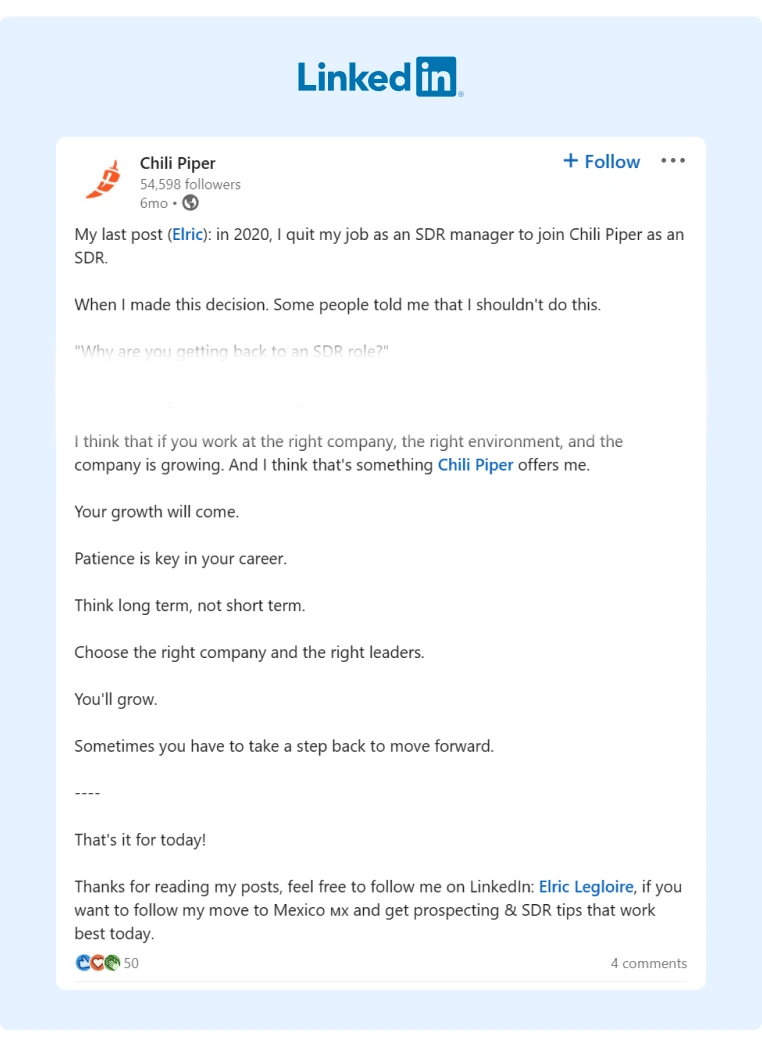 Source: Chili Piper
Source: Chili Piper
Another unique example of good employer branding is when they had to make some unfortunate layoffs. Instead of just dumping their employees, they posted about it publicly and helped them find new jobs.

Source: Chili Piper
This showed that they truly value their employees, and many of the commenters were also impressed by Chili Piper's efforts. So, they turned an unfortunate event into a great employer branding opportunity.

Source: Chili Piper
Starbucks
Starbucks is another great example of a company with a strong employer brand.
This post shows how they take some of their employees to their coffee farms in Costa Rica to learn more about how coffee is made, though the story also sends a stronger message about Starbucks as an employer.
In the story, the employee discusses how he moved to America and began working at Starbucks to learn English. It also indirectly plugs Starbucks' excellent benefits, mission and vision, and efforts to give back to the community.
 Source: Starbucks
Source: Starbucks
Walt Disney World
Disney is known for making dreams come true, so it’s no surprise that its employer branding strategy reflects this.
In a recent video, they show how one of their employees, who is deaf and has vision impairment, is fulfilling his culinary dreams with Disney.
Archer
Most employer branding examples discussed thus far center around how the brands value their employees, though Archer's employer branding strategy takes a slightly different approach.
It focuses primarily on the company's groundbreaking achievements. This strategy is excellent for attracting highly ambitious employees, as they are typically more attracted to big visions and want to have a hand in shaping the future.
In Archer's LinkedIn posts, you can see that they sell the vision of the company and its impressive accomplishments:
In fact, founder Brett Adcock publicly stated that it's easier to work on harder ideas with big missions because it makes it easier to attract top talent.
Booking.com
Booking.com takes a fairly traditional route to promoting its employer branding strategy, though it’s still highly effective.
First, they create posts announcing new employer awards and then ask their employees to share it with their networks. This helps them earn credibility as an employer and increase general brand awareness.
In addition, they frequently feature employee stories and share how Booking.com helped them achieve their career goals.
Finally, they regularly create posts celebrating special initiatives, like their Women in Leadership program, to show that they value diversity and inclusion.
New York Presbyterian Hospital
The New York Presbyterian Hospital’s employer branding strategy is a blend of celebrating employee stories, promoting groundbreaking accomplishments, and recognizing important appreciation weeks.
For example, on Doctors’ Day, they created a video celebrating their doctors. In the video, various doctors shared their stories and what they love about their job, which also indirectly promoted the career opportunities available to New York Presbyterian staff.
This post celebrating two NYPD employees’ side project, the Black Liver Health Initiative, also sends a strong message to potential employees that they fully support any kind of career growth opportunities:
How To Use These Employer Branding Campaigns To Inspire Your Strategy
There are plenty of different methods to improve your employer branding strategy. But if you already have a strong internal culture and just want more people to know about it, ask your employees to post about the company culture and what they love about working for your brand on social media.
If you need a tool that lets you streamline this process and send personalized engagement requests at scale, consider GaggleAMP.
You can learn more about how to set up an employee advocacy program or see the platform by scheduling a demo today.











